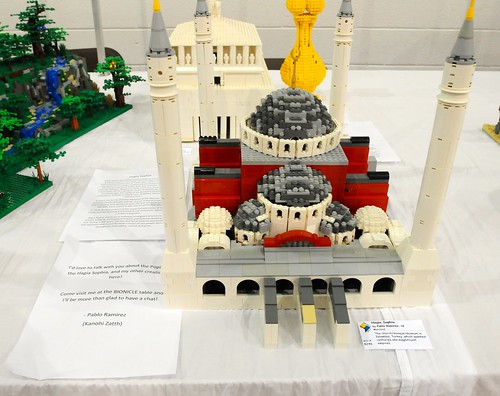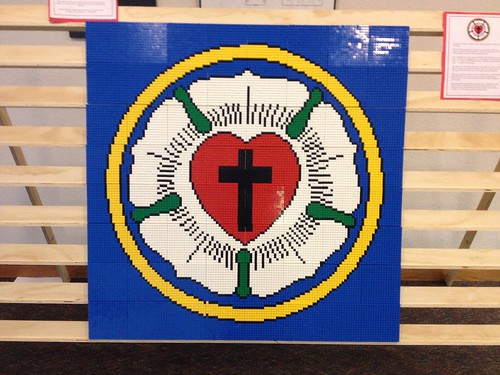
| Please visit the other 'Bricks' blogs: |
|
Thursday, August 22, 2013
Luther's Rose
Legozilla made this mosaic of Martin Luther's seal. The cross in a heart symbolizes Christ's sacrifice and a belief in this 'from the heart'. The white rose symbolizes joy, comfort and peace. The blue field is for a heavenly future surrounded by a golden ring symbolizing eternity.


Monday, August 19, 2013
Taiwanese Temple
I'm not sure if BLACKWHITE's Taiwan street temple is based on a specific temple or not. It certainly reflects the structural style of a lot of buildings like the Longshan Temple or the Confucious Temple, but it doesn't exactly match any that I can find. It might just be a combination of details from many different sites. Of course, since the builder is (I'm pretty sure) from Taipei, this doesn't have to be a particularly famous structure, it could just be a small temple down the street that he goes past every day. Can someone translate the text in the first picture for me?










Wednesday, August 14, 2013
You put the lime in the coke, you nut
In ancient times, the chewing of coca leaves was part of certain religious ceremonies in different cultures in the Andes of South America. The stimulant properties of the leaves are enhanced by adding a little bit of quicklime, as this helps neutralize stomach acid and increase the absorption of the alkaloids into the bloodstream. This lime was kept in ceremonial vessels known as poporos. Pablo Ramirez built this rendition of the Poporo Quimbaya, a gold artifact of the Quimbaya civilization dated to about 1700 years ago. This container has become somewhat of a symbol of pre-Columbian culture in Columbia, and appears on some of their currency.
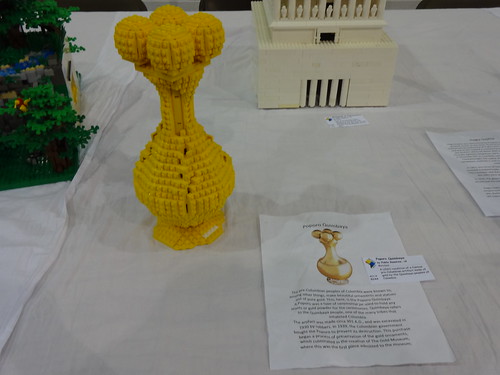
*While the practice of chewing coca leaves was restricted to upper classes in certain ceremonial uses in earlier times, in recent centuries it has become very common in some Andean regions. This has become a source of contention, as the US and international organizations wanting to stop the production of cocaine have come up against poor farmers who defend the production and chewing of the leaves (with a small amount of lime) as an indigenous practice. I've read conflicting reports from people on both sides of this, with some referring to the practice as essentially a low grade cocaine addiction, and others saying it is a folk remedy for altitude sickness and less of a kick than a cup of coffee.
**BTW, despite my title, the mineral lime used in the chewing of coca leaves has no relation to the citrus fruit lime. The word for the mineral comes from the Old English lim, which refers to a sticky substance, as lime was used in making mortar. The word for the fruit comes from the Arabic limah, referring to a citrus fruit. It's ironic that these two different meanings ended up with the same word in modern English, since the mineral is basic and the fruit is acidic. On the other hand, coca leaves are used in the production of Coca Cola, though ever since 1904 the leaves have first been processed to remove any cocaine.

*While the practice of chewing coca leaves was restricted to upper classes in certain ceremonial uses in earlier times, in recent centuries it has become very common in some Andean regions. This has become a source of contention, as the US and international organizations wanting to stop the production of cocaine have come up against poor farmers who defend the production and chewing of the leaves (with a small amount of lime) as an indigenous practice. I've read conflicting reports from people on both sides of this, with some referring to the practice as essentially a low grade cocaine addiction, and others saying it is a folk remedy for altitude sickness and less of a kick than a cup of coffee.
**BTW, despite my title, the mineral lime used in the chewing of coca leaves has no relation to the citrus fruit lime. The word for the mineral comes from the Old English lim, which refers to a sticky substance, as lime was used in making mortar. The word for the fruit comes from the Arabic limah, referring to a citrus fruit. It's ironic that these two different meanings ended up with the same word in modern English, since the mineral is basic and the fruit is acidic. On the other hand, coca leaves are used in the production of Coca Cola, though ever since 1904 the leaves have first been processed to remove any cocaine.
Tuesday, August 13, 2013
Pura Tanah Lot
Tanah Lot means 'Land in the Sea' - this rocky outcrop on the coast of Bali is cut off from the main land at high tide, and accessible by foot at low tide. During the 15th century, the traveling Hindu priest Nirartha rested at this spot, and was inspired by the beautiful location to found a shrine to worship the local sea gods. This recreation of Pura Tanah Lot is found in Legoland Malaysia.


Monday, August 12, 2013
Deir el Bahari
I've previously described, Deir el Bahari, a temple dedicated to the Pharoah Hatshepsut, honored as a god after her death. FifthPixel built this great rendition of this Egyptian site, illustrated here as if it were an official Architecture set.
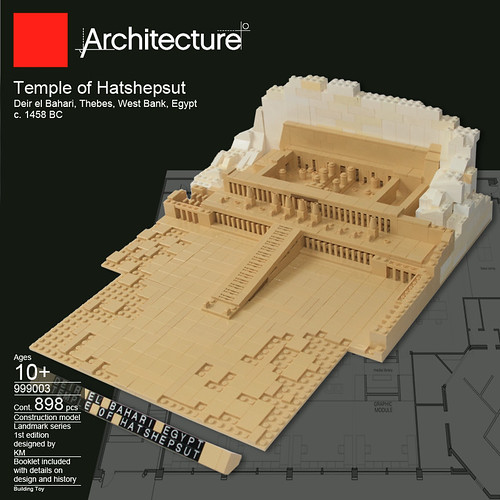

Saturday, August 10, 2013
Eid al-Fitr
I missed posting that a couple of days ago was Eid al-Fitr, holiday marking the end of Ramadan. A traditional greeting on this day is "Eid Mubarak", which translates as "Blessed feast". Last year Zam and Nadia wished their families and friends "Eid Mubarak" (which translates as "Blessed Feast") with this greeting card.


Friday, August 9, 2013
Wednesday, August 7, 2013
Roskilde Adventist Church
Lasse Vestergård and Anne Mette Vestergård built this great rendition of the Adventist Church in Roskilde, Denmark, on the occasion of its 50th anniversary.
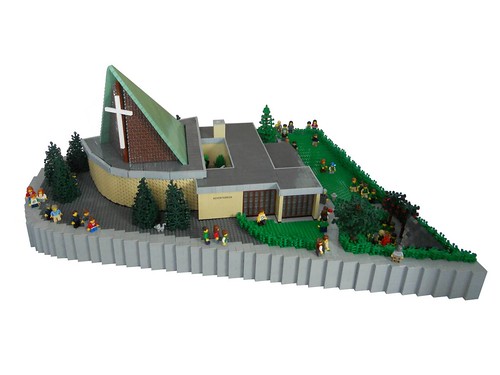

Subscribe to:
Comments (Atom)
